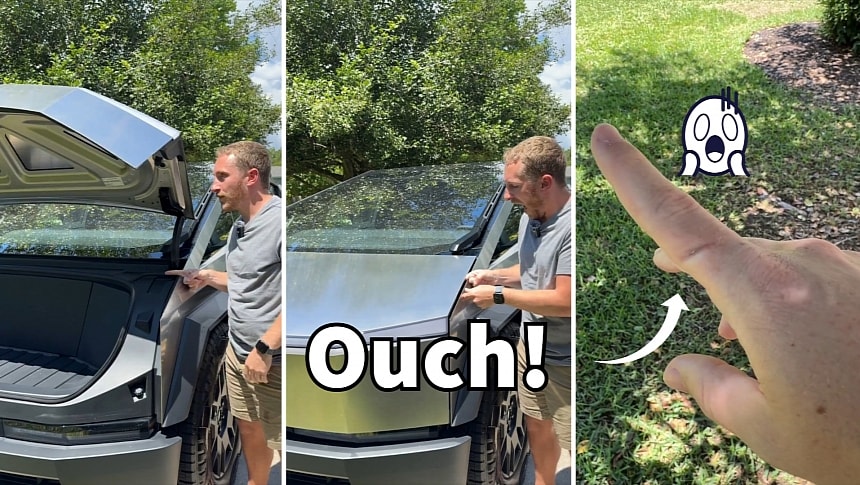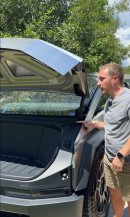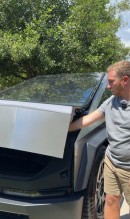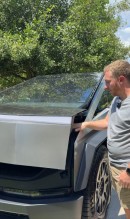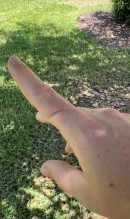Tesla improved Cybertruck's anti-pinch protection with the Spring update, but this was only because it had almost no protection before. People who tried the new feature were in for a nasty surprise, as the Cybertruck frunk only protects you the first time you try this. Tesla explained this only after a Tesla influencer almost got his finger crushed after repeating the stunt.
Tesla has been harshly criticized because the Cybertruck's frunk offered almost no anti-pinch protection. Instead of using optical sensors to detect objects in the way of the frunk door, Tesla relied on the frunk's electric motor to detect resistance and trigger an emergency opening. While this worked fairly well with bigger objects placed on the front side, it failed to react to smaller objects on the sides.
This explains why people who tried the anti-pinch protection in the Cybertruck's early days got their hands trapped under the frunk's door. After people criticized the lack of protection, which could put children in danger if they got their fingers in the frunk, Tesla finally agreed that something needed to be done. At the end of March, Wes Morrill, Tesla Cybertruck lead engineer, promised a big improvement in an upcoming over-the-air update. His team successfully deployed the fix with the Spring update, and the BBC Top Gear crew was the first to test it in one of their videos.
Of course, they were smart enough not to use their fingers for the demonstration. Instead, they used a banana, which was even more relevant, considering how soft it is. Top Gear Magazine's Editor-in-Chief, Jack Rix, showed how the powered frunk reacted to the banana in the blink of an eye. That was encouraging enough for everyone to rave about the beauty of Tesla's software updates.
The result encouraged other Cybertruck owners to "try this at home" despite the famous warning. Jeremy Judkins, a well-known Tesla fan and influencer, trusted Tesla enough to use his own hand to prove how much better the Cybertruck's pinch detection has become. That was a huge mistake! Although the Cybertruck anti-pinch system worked correctly with the arm and, to a lesser extent, with the hand, Jeremy almost had his finger crushed on the third attempt.
Despite doing something stupid, Jeremy's biggest mistake was not reading the non-existing fine print about how the new anti-pinch protection works. Indeed, the update's release notes were laconic, only writing that the powered frunk can now detect obstructions "just before it finishes closing." Jeremy was confident that it would work every time, protecting his fingers. However, Tesla had a bizarre idea about how it should work.
As Tesla's lead engineer Wes Morrill explained in a reply to Jeremy Judkins's video, the frunk pinch detection system uses a so-called "learning algorithm." Although it sounds like something intelligent is going on behind the scenes, the system is actually pretty dumb. It will increase the closing force each time the frunk tries to close without successfully latching. This explains why the frunk spared the arm and the hand but crushed Jeremy's finger on the third attempt.
Morrill explained that the algorithm assumes you know better if you repeatedly try to close the frunk. This could be useful when a big bag prevents the frunk from closing. In that case, the frunk will press harder each time until the job gets done. It's such a shame if, the third time, somebody's limb is in the way. I'm sure Tesla engineers will get back to destroying carrots (or bananas) until they make this as safe as possible.
This explains why people who tried the anti-pinch protection in the Cybertruck's early days got their hands trapped under the frunk's door. After people criticized the lack of protection, which could put children in danger if they got their fingers in the frunk, Tesla finally agreed that something needed to be done. At the end of March, Wes Morrill, Tesla Cybertruck lead engineer, promised a big improvement in an upcoming over-the-air update. His team successfully deployed the fix with the Spring update, and the BBC Top Gear crew was the first to test it in one of their videos.
Of course, they were smart enough not to use their fingers for the demonstration. Instead, they used a banana, which was even more relevant, considering how soft it is. Top Gear Magazine's Editor-in-Chief, Jack Rix, showed how the powered frunk reacted to the banana in the blink of an eye. That was encouraging enough for everyone to rave about the beauty of Tesla's software updates.
The result encouraged other Cybertruck owners to "try this at home" despite the famous warning. Jeremy Judkins, a well-known Tesla fan and influencer, trusted Tesla enough to use his own hand to prove how much better the Cybertruck's pinch detection has become. That was a huge mistake! Although the Cybertruck anti-pinch system worked correctly with the arm and, to a lesser extent, with the hand, Jeremy almost had his finger crushed on the third attempt.
Despite doing something stupid, Jeremy's biggest mistake was not reading the non-existing fine print about how the new anti-pinch protection works. Indeed, the update's release notes were laconic, only writing that the powered frunk can now detect obstructions "just before it finishes closing." Jeremy was confident that it would work every time, protecting his fingers. However, Tesla had a bizarre idea about how it should work.
As Tesla's lead engineer Wes Morrill explained in a reply to Jeremy Judkins's video, the frunk pinch detection system uses a so-called "learning algorithm." Although it sounds like something intelligent is going on behind the scenes, the system is actually pretty dumb. It will increase the closing force each time the frunk tries to close without successfully latching. This explains why the frunk spared the arm and the hand but crushed Jeremy's finger on the third attempt.
Morrill explained that the algorithm assumes you know better if you repeatedly try to close the frunk. This could be useful when a big bag prevents the frunk from closing. In that case, the frunk will press harder each time until the job gets done. It's such a shame if, the third time, somebody's limb is in the way. I'm sure Tesla engineers will get back to destroying carrots (or bananas) until they make this as safe as possible.
Frunk pinch detection is a learning algorithm which will increase the closing force each time it's cycled back to back without successfully latching.
— Wes (@wmorrill3) May 2, 2024
Imagine there is a big bag inside the frunk it might also trigger the pinch detection. Then you might try closing it again, and…
